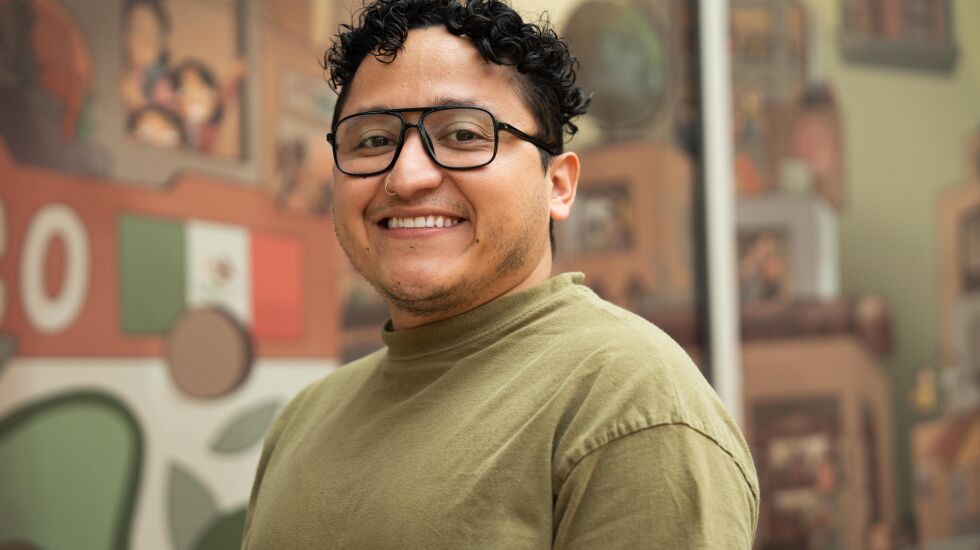
Walking around Albany Park, you can find a building mailbox that lists families from around the world who have found themselves now living in the same place, says David Feiner of the Albany Park Theater Project.
In “Port of Entry,” the theater company, a mix of youth and adult artists, and Third Rail Projects aim to tell the stories of an immigrant community in the Northwest Side neighborhood.
The newly opened play has a sold-out summer season. Additional performances are expected to be announced with pay-what-you-can tickets.
Patrons seeing the play will enter a commercial building at 3547 W. Montrose Ave. and walk into the world of “Port of Entry” — a three-story, multi-unit apartment complex that itself becomes a character.

Those attending the performances will walk through a courtyard before going into apartments where the stories of four families — spanning 100 years — will unfold. The 28 people in the audience might find themselves playing a game of loteria or helping cook a meal through the course of the two-hour, immersive production.
“We kind of think about immersive theater as a multisensory experience,” says Jennine Willett, co-artistic director of Third Rail Projects. “It’s not just what you see. It’s what you’re sitting on, what you feel, what you smell, what you hear, what you touch. All of the senses are engaged. Also, how does your body feel in a space whether you feel like you’re cramped in the space or you feel like it’s very spacious.”

Porches resembling the brick-and-wood structures that are a familiar feature of buildings across the city bridge the homes, bringing them together.
The apartments are outfitted with technology to transform the space from day to night and help symbolize the passage of time as audience members move through the stories.
Each space was curated to tell the stories of the families, with items inspired by homes of Albany Park residents and student artists.

In one of the homes, mats were added after Mulay Ku, one of the student artists, talked about how her family had faced a hard time adjusting to beds and instead slept on prayer mats together in their living room when they resettled in the United States.
One of the stories in the play was inspired by Ku’s family, who fled Myanmar and sought refuge in Thailand before coming to the United States. Ku says it was strange at first to have her own story in the play. She says she hopes audiences walk away with a better understanding of the immigrant community.
“I was happy to share,” says Ku, who recently graduated from Theodore Roosevelt High School. “It’s a story that people will know and hear about. And then they’ll learn and also figure out what they can do. Because many people are coming here for help, for jobs and opportunities as well.”
Beatriz Gigante, one of the student artists who plays a role in the home inspired by Ku’s family, says learning about Ku’s family inspired her to do more research about Myanmar and that she ended up writing about it as part of a high school project.

She says it also made her feel proud of her own immigrant roots after facing discrimination early on in school. In the Albany Park Theater Project and in the cast of “Port of Entry,” she says she found a space where she could freely embrace her roots.
“I didn’t learn to take pride in those things until I entered the [Albany Park Theater Project] space because it really tells the stories of who we are,” says Gigante, a recent graduate of Von Steuben Metropolitan Science Center.
The idea for “Port of Entry” dates to 2014, when the Albany Park Theater Project and Third Rail Projects first got together and brainstormed ideas, Willett says. The creative team started working on the play in 2018, but then the coronavirus pandemic hit. Feiner, who is co-director with Miguel Angel Rodriguez, says they and others involved in the project came up with ways to continue working on it even as there were questions about whether immersive theater would ever return.

“At a time of social distancing, would audience members ever want to come and be a foot away from performers and other audience members or be in a kitchen scene cooking together?” Feiner says. “We just said: Yes, it’s going to happen.”
The goal, Feiner says,is for the production to become a fixture in the community, with the expectation that not every experience will be the same. He says it was particularly important for Rodriguez, who grew up in Albany Park, for the play to stay in the neighborhood and for the audience to be immersed in the community.
“Miguel really likes to talk about the importance of telling these stories in a powerful way right here in this community, for the people who live here in this community to experience,” Feiner says. “And for people who live throughout the city and beyond to come to this neighborhood and experience a performance like ‘Port of Entry’ and experience these stories rather than seeing them on a TV or on a downtown stage.”

Elvia Malagón’s reporting on social justice and income inequality is made possible by a grant from The Chicago Community Trust.







